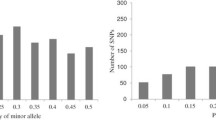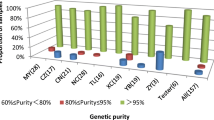Summary
The coefficient of coancestry (fAB) between individuals A and B is the classical measure of genetic relationship. fAB is determined from pedigree records and is the probability that random alleles at the same locus in A and B are copies of the same ancestral allele or identical by descent (ibd). Recently, the proportion of molecular marker variants shared between A and B (SAB) has been used to measure genetic relationship. But SAB is an upwardly-biased estimator of fAB, especially between distantly-related lines. fAB, SAB, and adjusted (to remove bias) estimates of molecular marker similarity (f MAB ) were compared. RFLP banding patterns at 46 probe-restriction enzyme combinations were obtained for 23 maize inbred lines derived from the Iowa Stiff Stalk Synthetic (BSSS) maize (Zea mays L.) population, and for 4 non-BSSS lines. f MAB was estimated as \({\text{f}}_{{\text{AB}}}^{\text{M}} = \left[ {{\text{S}}_{{\text{AB}}} - \tfrac{1}{2}\left( {\delta _{{\text{A}}{\text{.}}} + \delta _{{\text{B}}{\text{.}}} } \right)} \right]/\left[ {1 - \tfrac{1}{2}\left( {\delta _{{\text{A}}{\text{.}}} + \delta _{{\text{B}}{\text{.}}} } \right)} \right]\), where δ A (or δ B) was the average proportion of RFLP variants shared between inbred A (or inbred B) and the non-BSSS lines. The average fAB among 253 pairwise combinations of BSSS lines was 0.212, whereas the average SAB was 0.397. The average f MAB was 0.162, indicating that the upward bias in SAB was effectively removed. SAB and fAB were significantly different (α = 0.05) in 76.3% of the comparisons, whereas 24.9% of the f MAB values differed significantly from fAB. The latter result suggests that selection and/or drift were present during inbred line development and that fAB may not be an accurate measure of the true proportion of ibd alleles between two lines. Cluster analyses based on S MAB and f MAB grouped lines according to pedigree, although several exceptions were noted. The presence of shared molecular marker variants between unrelated lines must be considered when setting SAB-based minimum distances for varietal protection. Under simplified conditions, more than 250 molecular marker loci are necessary to obtain sufficiently precise estimates of coefficient of coancestry using molecular markers.
Similar content being viewed by others
References
Cowen NM, Frey KJ (1987) Relationship between genealogical distance and breeding behavior in oats (Avena satva L.). Euphytica 36:413–424
Cox TS, Kiang YT, German MB, Rodgers DM (1985) Relationship between coefficient of parentage and genetic similarity indices in the soybean. Crop Sci 25:529–532
Dudley JW, Saghai-Maroof MA, Rufener GK (1991) Molecular markers and grouping of parents in maize breeding programs. Crop Sci 31:718–723
Efron B (1981) The bootstrap, the jackknife, and other resampling plans. Soc Ind Appl Math, Philadelphia, Pa
Falconer DS (1981) Introduction to quantitative genetics, 2nd edn Longman, London
Godshalk EB, Lee M, Lamkey KR (1990) Relationship between restriction fragment length polymorphisms to single-cross hybrid performance of maize. Theor Appl Genet 80:273–280
Hallauer AR (1990) Methods used in developing maize inbreds. Maydica 35:1–16
Helentjaris T, Slocum M, Wright S, Schaefer A, Nienhuis J (1986) Construction of genetic linkage maps in maize and tomato using restriction fragment length polymorphisms. Theor Appl Genet 72:761–769
Henderson CB (1984) Maize research and breeders manual. No. 10. Illinois Foundation Seeds, Champaign, Ill
Hunter RB (1989) ASTA approach on minimum distance. Corn Sorghum Industry Res Conf 44:193–195
Lynch M (1988) Estimation of relatedness by DNA finger-printing. Mol Biol Evol 5:584–599
Malécot G (1948) Les mathématiques de l'hérédité. Masson et Cie, Paris
Melchinger AE, Messmer MM, Lee M, Woodman WL, Lamkey KR (1991) Diversity and relationships among U S maize inbreds revealed by restriction fragment length polymorphisms. Crop Sci 31:669–678
Messmer MM, Melchinger AE, Lee M, Woodman WL, Lee EA, Lamkey KR (1991) Genetic diversity among progenitors and elite lines from the Iowa Stiff Stalk Synthetic (BSSS) maize population: comparison of allozyme and RFLP data. Theor Appl Genet 83:97–107
Smith OS, Smith JSC, Bowen SL, Tenborg RA, Wall SJ (1990) Similarities among a group of elite maize inbreds as measured by pedigree, F1 grain yield, grain yield, heterosis, and RFLPs. Theor Appl Genet 80:833–840
Souza E, Sorrells ME (1989) Pedigree analysis of North American oat cultivars released from 1951 to 1985. Crop Sci 29:595–601
Sprague GF (1946) Early testing of inbred lines of corn. J Am Soc Agron 38:108–117
Author information
Authors and Affiliations
Additional information
Communicated by A. R. Hallauer
A contribution from Limagrain Genetics, a Group Limagrain company
Rights and permissions
About this article
Cite this article
Bernardo, R. Estimation of coefficient of coancestry using molecular markers in maize. Theoret. Appl. Genetics 85, 1055–1062 (1993). https://doi.org/10.1007/BF00215047
Received:
Accepted:
Issue Date:
DOI: https://doi.org/10.1007/BF00215047




